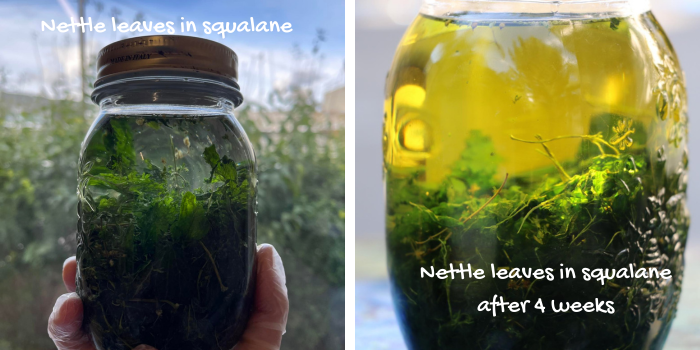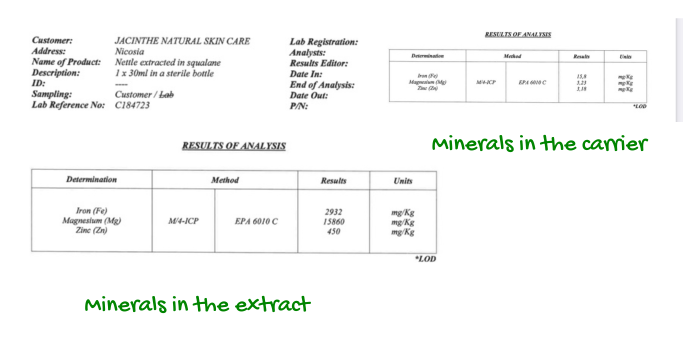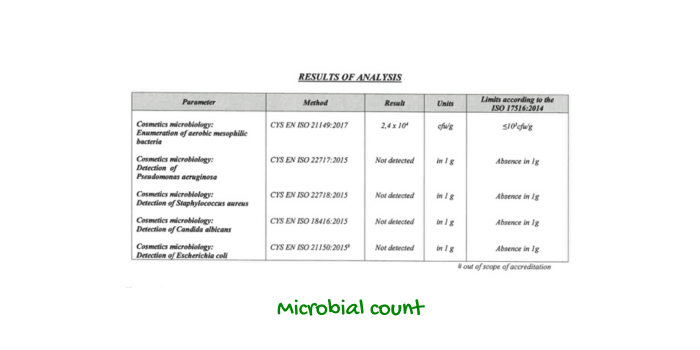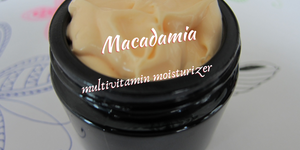
This post is written by Andry from Jacinthe Naturals who is one of highly valued members, customers and students. I highly recommend you have a look at her website just for the sake of reading the background for naming her company and products.

Making infusions and macerations is a fun part of artisanal skin care and most of us do this in a daily basis. What Andry does in addition is sending her extracts to laboratory for a thorough chemical and microbial analysis so that she makes sure:
1- the extract she is using is safe in addition to useful
2- She knows what she is using because she cares more than just a pretty and catching name of an extract on the label
In this post she generously shares the steps in making a nettle extract in olive squalane. In addition to sharing her procedure and as she is an academic, she shares her experiment design and objectives.
To be honest, in all my years of formulating I never came out to the idea of making a lipophilic nettle extract. Andry did this and used the extract later in a hair mask with amazing results. I hope she will share her secrets to making the mask in a later post as well.
Before you continue I recommend you go back to part I of this post with a general information about making plant extracts in the lab.
Stinging Nettle : the Gentle Giant
We see this beautiful herb growing near streams and around old farm sites in patches of land where no human activity is taking place. They have a beautiful vibrant green colour, their stems are slender and they have toothed leaves that are distinctly veined. When fresh, a stinging nettle can sting like a bee and can be quite painful. This is due to their stinging hairs that are about a millimeter long and are mostly found along the stems and undersides of the leaves. During their harvest we normally wear long sleeves and gloves to avoid getting stung.
The burning-itching-tingling sensation caused when handling it with bare hands is a result of a stinging hair/needle releasing onto the skin a small dose of histamine, acetylcholine, serotonin and formic acid. This burning and tingling sensation causes irritation that might last for several hours.
Skin-wise, it offers so much to the skin. It helps acne prone skin, soothes inflamed and itchy skin and due to its astringent properties, it also makes the pores look smaller. We know that Nettle is rich in numerous minerals particularly Iron, Magnesium and Zinc. These are all important nutrients for skin and hair. Zinc has anti-inflammatory properties which is a great nutrient to have in skincare that treats eczema, acne and rosacea. A low zinc count in our organism is associated with increased hair loss. For this reason, zinc supplements are often taken to reduce hair loss and strengthen hair.
Magnesium, is known to calm sensitive skin and reduce the damage free radicals cause to cells; hence, a great anti-aging nutrient to have in skincare products. For hair care, magnesium regulates hair follicle production which, in turn, produce new hair. Lastly, iron, reduces dark spots and gives the skin a healthy glow. In hair care this mineral helps to boost circulation in the hair roots and support hair growth and scalp health.
Procedure of Study :
- Questions considered
I have selected to study nettle closely knowing about its valuable properties for both skin and hair. I wanted to prepare an extract that would treat flaky, irritated scalp but also something I could use to soothe sensitive and dry skin. Hence, after deciding to make use of nettle I also had to decide what oil to extract it in. Here, there are several factors I owed to consider:
- What is the extract going to be used for?
- What is the iodine value of the chosen carrier?
- What method of oil extraction will be used?
As one realizes, all of these three questions are interrelated as one informs the other. After carefully considering what I wanted this oil extraction to be used for (i.e. soothe skin, lock in moisture, strengthen hair), it was decided to go for an oil that would offer these qualities as a menstruum (the carrier of the plant matter) but also suitable for the skin and hair needs under question. Moreover, the iodine value had to be considered to ensure that the oil can remain stable during the 4-week extracting procedure. Elham wrote an article for Formula Botanica a few years ago that explains why knowing the iodine value of each carrier is important in helping us decide whether a specific plant oil is appropriate for a particular use (e.g. if it can be heated during the oil phase or if it can be used as a menstruum in oil extractions when heat is applied).
In this specific case, squalane was selected because it is a rather stable oil , it is an oil we use to reduce TEWL, it is quite emollient for hair, scalp and face. Its transparent color would also allow the colour of the nettle extract to predominate (vibrant yellow) without toning it down. Its iodine value ranges in the literature from 2-4 which makes it a great oil to use in either the heat phase of a product or in a extraction procedure that requires low heat. Generally, it is suggested that we avoid using plant oils as menstruums (solvent, carrier in this case) that have a higher iodine value of 100 for oil extractions that require heat, as these are considered heat sensitive and oxidize faster than other more stable oils.

- Oil extraction
After drying the nettle in the dehydrator at 50 degrees Celsius (140F) for about 2 hours, the leaves were removed from the stems and allowed to stand for an hour to cool. Then I filled a glass jar, I previously sterilized in the oven at 200 degrees centigrade for 35 minutes, with 30gr dried nettle leaves and 400gr olive squalane. I ensured that the plant matter was completely immersed in the oil and pushed it gently down with a sterilized rod. The jar was tightly closed and placed in a dark cupboard. Every day I would open the jar and give it a stir for the next 4 weeks. The purpose of this was to check the iron, magnesium and zinc count of the menstruum after the nettle extraction when no heat was applied.


Results
4 weeks later the plant matter was removed with a manual presser and a 30ml sample in a sterilized plastic jar was sent to a specialized lab to measure the count for the three minerals I was interested in. In addition, a 30ml sample of the squalane alone was also sent so that we would measure these minerals prior and after extraction of the same carrier.

The results were astonishing indeed, see the tables below.

The samples were tested negative for Pseudomonas aeruginosa, Staphylococcus aureus, Candida albicans and Escherichia Coli and considered ok to use in cosmetic formulas. I was told that the presence of aerobic mesophilic microorganisms was considered normal since we were working with plant matter and that they would not cause mold or bacteria to develop in a product as long as preservation was used.

I have now sent another sample to be tested for numerous other minerals, including these 3 and a polyphenol count I was very much looking forward to. This time, a different extraction method was applied where temperature and time where the factors that changed. I am looking forward to receiving the results and comparing with the first set received.



